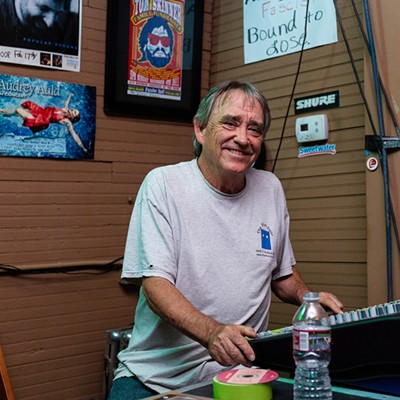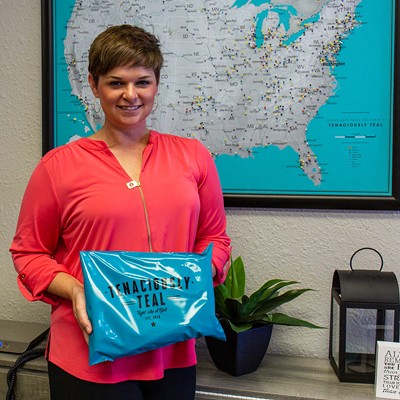“No one,” another replied as they walked toward a shade tree at a Sept. 30 meeting at Will Rogers Park.
The protests on Wall Street in New York City have grown, and even spread to other cities around the country. And that’s what the crowd of about 150 hoped to do at the northwest Oklahoma City park — organize a similar protest in OKC.
The protests, generally referred to as “Occupy” in the various locations they are held, received very little attention up until a few days prior to the meeting. But now, the movement has taken on a life of its own.
right, Chris McLaughlin hands out leaflets to Celeste Warden and Cameron Rodgers at Kerr Park.
The Occupy OKC group spent much of the meeting breaking off into subgroups, discussing various strategies, logistics and motivations for their own protest, and by the second “general assembly” on Oct. 7, had determined a protest date of Oct. 10.
The meetings, called exclusively via social network sites like Facebook and Twitter, were somewhat unique, in that there was no leader or leading body. Ideas were accepted or rejected by a vote of the entire group, and people volunteered to serve on different committees that emerged from the discussion, ranging from possible medical needs to committees to shape the group’s message and manage the media.
The sometimes chaotic atmosphere and leaderless organizational structure make the group harder to co-opt, said John Dunlap, one of the attendees.
“I think it’s important to not have leaders who can be co-opted and bought off,” Dunlap said.
Watch an exclusive video of protest organizer Jay Trenary discussing his motivation with Oklahoma Gazette reporter Clifton Adcock:
Although the group was composed of many left-leaning and mostly young individuals, it also included Ron Paul supporters, some white-collar workers, several middle-aged and older individuals, and even a self-described Republican or two.
Protesters said they hoped to keep partisan politics out of the affair. The idea, many in the group said, is to represent the 99 percent of Americans, rather than the wealthiest 1 percent.
“The 99 percent is the vast majority of the general population. There are the few that have the money to throw their weight around and throw their interests around,” said Kate Schwartz, one of the group’s participants.
“In the end, the point is not what your particular belief is, it’s that your belief is heard. The 99 percent is drowned out by the interests of the 1 percent. Politicians meet with lobbyists — they don’t meet with constituents — and that is the root of the problem. They are not listening to us.”
When asked for the reasoning behind the protest, one didn’t receive a slick PowerPoint presentation of demands; rather, a whole host of issues rose to the surface, including economic and social inequality, continued wars and the death penalty.
right, Protesters at Kerr Park learning hand signals.
However,
despite disagreement on some of the protest issues, the linchpin in
each members’ involvement remained essentially the same: the belief that
the system under which average Americans live has become fundamentally
corrupt; that the very pillars of the democratic process and a
democratic society have been subverted by corporations and the wealthy
elite; that the majority of Americans have little voice in the system;
and that the playing field has been tilted to exclusively favor those
interests.
“We’ve
gotten to a point where we’re not being accurately represented,” said
participant Patrick Morris. “If a corporation wants to use money, that’s
great. What Devon and Chesapeake have been doing in this city has been
fantastic. They’ve built things for the city; they’ve done a lot of
community projects. That’s good stuff.
But
using that money in order to further their gains against the rest of
the American people, that’s draconian tactics, and it’s class warfare in
the end.
“The system itself is breaking down.”
The
Occupy movement started in the summer when Canadian anti-consumerist
magazine Adbusters put out a call for people to occupy Wall Street on
Sept. 17. The protest gained support from the online hacker collective
Anonymous and within a few days had spread to other cities such as Los
Angeles, Boston and Chicago.
Oklahoma has four protest locations: at college campuses in Norman and Stillwater and in Tulsa and Oklahoma City.
At a
second general assembly consisting of about 150 people on Oct. 7,
attendees decided to hold an official protest at 6 p.m. on Oct. 10. It
was not immediately clear as to whether the protest would be a
single-day event or a prolonged effort, although social media messages
from the group stated that if protestors wanted to bring tents to set
up, they could.
Watch an exclusive video of Occupy OKC protester Tom Lucas discussing his involvement with the movement with Oklahoma Gazette reporter Clifton Adcock:











